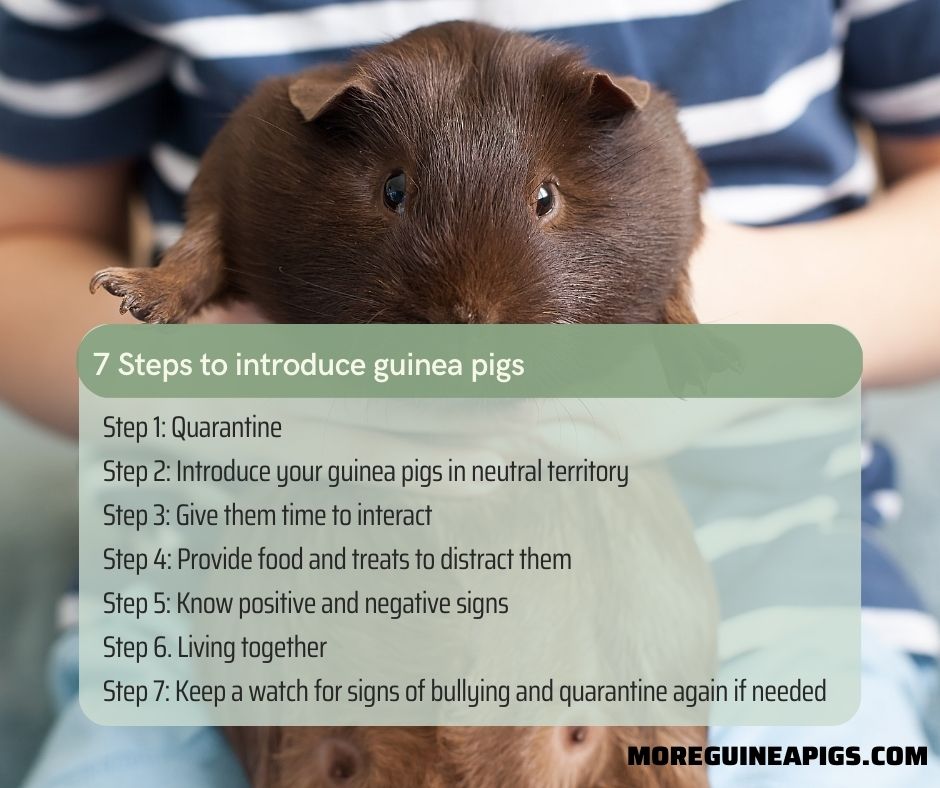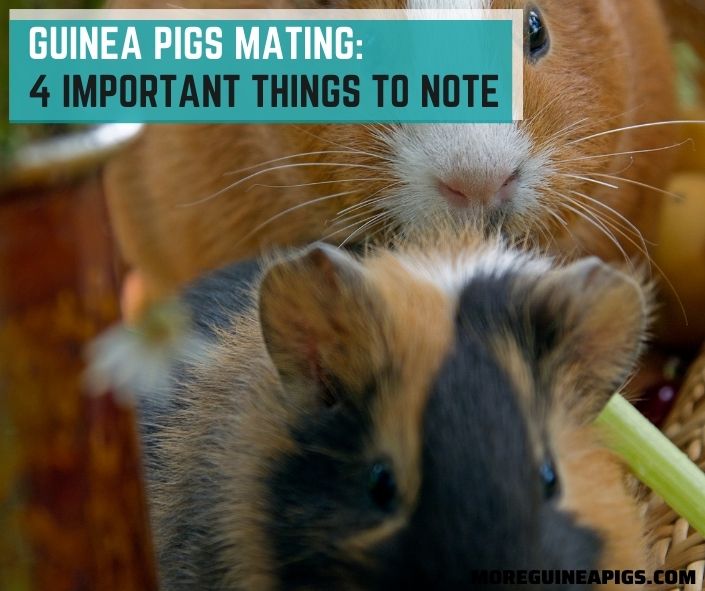How To Introduce Guinea Pig
Guinea pigs need companions as they are highly sociable by nature. Single guinea pigs often tend to get bored, depressed, and lonely. Therefore, it is a good idea to keep pairs of guinea pigs or, if you can manage it, even herds of three or more guinea pigs.
However, introducing a new guinea pig to an existing cavy or a herd of cavies should be done gradually. You also need to take several factors into account such as the piggies’ ages, gender, and especially their temperaments.
That is the topic of this guide. We will tell you step-by-step how to introduce guinea pigs and also cover other important questions on this topic.
Things To Consider When Introduce A New Guinea Pig
In the wild, guinea pigs live in groups. Naturally, they tend to be happier when they have a cage mate or two. According to FourPaws.org, guinea pigs need companions to stimulate each other and encourage active behavior.
But before you introduce the new guinea pig to your existing piggy, it is important that you consider certain things:

- Your Guinea Pigs’ Gender
The best pairings of guinea pigs are two females and you can also have one neutered male with a female. Alternatively, you can keep one neutered male with two or more females or two neutered males with two to three females.
Two boars (male cavies) might get along as long as there are no females to compete over.
So always make sure that you know your cavies’ genders. If unsure, please check with your vet.
- The Age of the Guinea Pigs
It is important that the age of the guinea pigs is similar since that will keep their activity levels similar too.
A baby male cavy might get along with a senior or adult male cavy but do make sure you introduce them properly first. We will cover the steps of introduction in the next section.
- Quarantining the New Guinea Pig
Quarantine is the process of holding the new guinea pig in another cage away from the cage of your existing cavy or herd of cavies. By quarantining, you can observe your new piggy’s behavior and also ensure that it is healthy and free from diseases.
Quarantining also helps your new guinea pig adjust and acclimatize to its new environment while you understand its diet, likes, and dislikes.
Also Read: Do Guinea Pigs Need Cage Mates
7 Steps to Introduce Guinea Pigs
The following steps will help you introduce your cavies safely so they can start living harmoniously and without conflict.
The seven steps to introduce guinea pigs are quarantine period, introduction in neutral territory, taking measures to resolve fights, giving them time, looking out for signs of good and bad behaviors, actually staying together, and identifying signs of bullying.

Let us study these in depth.
Step 1: Quarantine
Follow a quarantine period for your new cavy for 2-3 weeks. Provide a separate cage to it and you may locate this in another room from that of your existing pet’s cage.
It is best to feed your new cavy the same food that the breeder was feeding it. If you plan to make any dietary changes, do so gradually.
Watch out for signs of ill-health and behavioral issues in the new piggy during the quarantine period.
Step 2: Introduce Your Guinea Pigs in Neutral Territory
Following the 2-week quarantine period, it is time to introduce your guinea pigs. You need to do this in the neutral territory such as a safe and secure playpen or an outside run.
You may even place all cavies in the same cage but with a sturdy barrier in between. If that is not possible, create a barrier in the neutral space so they get to sniff each other out.
You can remove the barrier if your guinea pigs show positive behaviors such as:
- Staying at the barrier.
- Trying to jump over the barrier.
- Continuously sniffing at the barrier
- Showing curiosity to meet the new guinea pig.
Step 3: Give Them Time to Interact
Once you remove the barrier, give your pets some time to interact. Two females or two males might show some aggression towards each other. This is necessary for establishing social hierarchy or dominance.
Don’t worry, most guinea pigs get along within a couple of hours. Just make sure there are plenty of hideouts and open-ended tubes and boxes in the neutral area for your cavies to hide or simply to have a quiet space of their own.
Some guinea pigs bond instantly while others may take longer. Keep a piece of cardboard handy so you can act quickly in an emergency and separate the fighting guinea pigs.
Kaytee Igloo Habitat Hideout For Pet Guinea Pigs
Step 4: Provide Food and Treats to Distract Them
During the introduction, it is a good idea to provide all cavies with food and treats. That way, they start associating the sessions with positive things.
You can feed salads or special guinea pig treats they like. Fruits are also a great option but do make sure they are acceptable to feed guinea pigs.
Check out our guide on What Can Guinea Pigs Eat.
Step 5: Know Positive and Negative Signs
It is important to introduce your guinea pigs when you’re sure you have the time to observe them. That way you can monitor them throughout and also know which behaviors are acceptable and unacceptable.
For example, the positive or acceptable behaviors include:
- Your cavies start sharing food
- They start grooming each other
- They lay next to each other.
Negative behaviors or unacceptable signs include:
- Signs of aggression
- One cavy tries to keep the other from eating or drinking
- Teeth chattering
- Chasing each other
- Not spending time together
If you notice these negative signs, end the session and try again the next day. Several sessions of this sort should do the trick.
Step 6. Living Together
After you start noticing positive signs and behaviors from your pets, you can move them together in the same cage.
A good cage for multiple guinea pigs has the following characteristics:
- If you have two piggies, the cage should be at least 30 inches x 50 inches. If you have three pigs, it should be 30 inches x 62 inches – bigger the better.
- Provide plenty of open-ended hideouts for your cavies – tubes, open boxes, etc.
- Place food all over the cage and keep multiple water sources to prevent conflict and fights.
- Continue to monitor your cavies. A new environment could trigger behavioral changes and could lead to conflicts even if they showed positive behavior in neutral surroundings.
- If you feel your cavies need some more monitoring, then only leave them together only when you have the time to observe them. Otherwise, keep your pets separated.
Guinea Habitat Guinea Pig Cage by Midwest
Step 7: Keep a Watch for Signs of Bullying and Quarantine Again if Needed
It can be difficult to tell if your guinea pigs are playing with each other or if one is bullying the other. For example, females tend to mount each other when they are in heat, or two males might playfully chase or play bite each other.
In either case, you might hear squeals or see your pets chasing each other around. That can be difficult to tell whether one pig is being bullied by the other.
The thing with guinea pigs is that there will always be one piggy that is more dominant than the other.
You can take the following precautions to ensure that your pets are doing well:
- Conduct thorough checks and watch out for injuries or bite marks.
- Weigh every pig each week to ensure no one is losing weight.
If one pig continues pestering the other to no end, add several hideouts in the cage. If that does not work, consider another short quarantine period and separate them for a few days.
An after-fight quarantine will give your cavies time to cool down. If needed, keep their cages next to each other so they can see and smell each other but still remain separated.
How Long Does It Take for Guinea Pigs To Bond With Each Other?
Most guinea pigs will spend 1-3 hours establishing dominance when they are introduced for the first time. After this period, they may require another hour to get to know each other better.
Give your pets time and have patience. Some piggies bond instantly over an afternoon while others may take 2-3 weeks or even up to a month to develop a bond.
Whatever you do, always conduct the introduction on neutral grounds. Never plop a new guinea pig in the existing pigs’ cage right away. This is very important for your pigs’ safety.
Conclusion – How to Introduce Guinea Pigs?
If you plan to add another guinea pig to an existing pig’s cage, it is important to follow certain rules. Before introducing, follow a quarantine period of up to 2 weeks to ensure that the new pig is disease-free.
You need to conduct several introductory sessions to help familiarize the new and existing cavies’ with each other’s smell. Conduct these sessions in neutral territory.
Introducing guinea pigs is a gradual process – never house the new pig with the existing pig or herd right away.
Continue monitoring your pets’ behavior carefully even after the initial meeting. If there are signs of bullying, separate the pigs and try again after a few days.
We hope this guide helps you introduce your guinea pigs safely and harmoniously.






